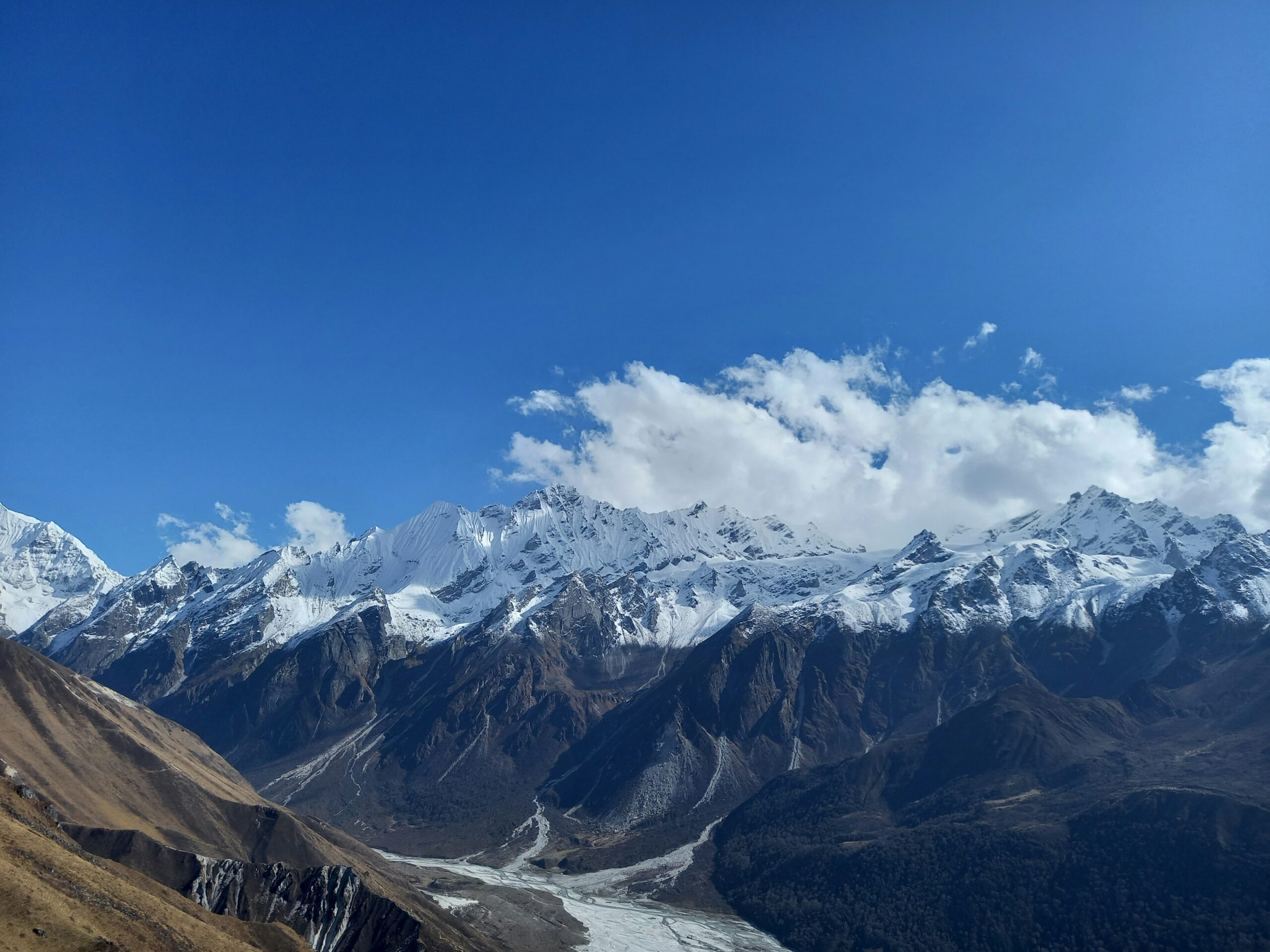
The Langtang Trek is a stunning Himalayan journey that offers an ideal blend of natural beauty, cultural depth, and accessibility. Located just north of Kathmandu, the Langtang Trek takes you through quiet valleys, traditional Tamang villages, and lush forests, all the way to high mountain viewpoints with panoramic views of snow-capped peaks. Often overlooked in favor of Everest and Annapurna, this hidden gem provides a peaceful, less-crowded alternative, perfect for those seeking an authentic trekking experience in Nepal.
Why Choose the Langtang Trek?
- Easy Accessibility
Begin your trek with a scenic 7–8 hour drive from Kathmandu to Syabrubesi—no need for domestic flights. - Spectacular Mountain Views
Enjoy stunning panoramas of peaks like Langtang Lirung (7,245m), Dorje Lakpa (6,990m), and Langtang Ri (6,370m). - Rich Culture
Explore Tamang and Sherpa villages, visit sacred monasteries like Kyanjin Gompa, and witness the rebuilding spirit of communities after the 2015 earthquake. - Biodiversity & Nature
Trek through rhododendron and bamboo forests, and spot rare wildlife such as red pandas in Langtang National Park. - Moderate Difficulty
Suitable for trekkers with average fitness. The trail offers a rewarding challenge without the crowds of more popular routes.
Langtang Trek Highlights
1. Kyanjin Gompa
Kyanjin Gompa is a beautiful Buddhist monastery located at around 3,870 meters above sea level. It’s surrounded by tall snow-covered peaks and is one of the most important spiritual places in the Langtang region.
- Why it’s special:
It’s a peaceful spot where trekkers can learn about Tibetan Buddhist culture, interact with monks, and enjoy stunning mountain scenery. The village around the monastery also offers fresh yak cheese from a local cheese factory.
2. Tserko Ri & Kyanjin Ri
These are two popular high viewpoints near Kyanjin Gompa:
- Kyanjin Ri (about 4,773 meters): A shorter climb, great for a morning or evening hike.
- Tserko Ri (about 5,000 meters): A more challenging hike, but offers 360-degree views of the Langtang Himalayas.
- Why it’s special:
Watching the sunrise from these peaks is a magical experience. You’ll see the mountains glow with golden light, with views of Langtang Lirung, Yala Peak, and other Himalayan giants.
3. Traditional Villages
Throughout the trek, you’ll pass through several small, charming villages like Lama Hotel, Langtang Village, and Kyanjin Gompa.
- Why it’s special:
These villages are home to the Tamang people, an ethnic group with Tibetan roots. You can experience their hospitality in local teahouses, learn about their culture and lifestyle, and taste traditional food—including yak cheese and butter tea.
4. Langtang National Park
Langtang Trek takes you through Langtang National Park, Nepal’s first Himalayan national park.
- Why it’s special:
The park is full of beautiful forests, rivers, and wildlife. You might spot:
- Red pandas (very rare and shy)
- Himalayan black bears
- Musk deer
- Monkeys
- Colorful birds like the Himalayan monal (Nepal’s national bird)
- Red pandas (very rare and shy)
It’s also home to rhododendron forests that bloom in spring, making the trail even more beautiful.
Sample Langtang Trek Itinerary (Days)
- Day 1: Arrival in Kathmandu & Transfer to Hotel
Upon arrival at Tribhuvan International Airport in Kathmandu, you will be warmly welcomed by Sherpa Expedition and Trekking staff and transferred to your hotel. After check-in, you’ll receive a short briefing regarding your upcoming trek.
For a peaceful stay in the capital, book your hotel with Attic Inn Kathmandu. - Day 2: Drive from Kathmandu to Syabrubesi (1,440m) – 7–8 hours
Leave Kathmandu by tourist bus or private vehicle and embark on a scenic journey to Syabrubesi, the starting point of the Langtang Trek. The road climbs out of the Kathmandu Valley, offering incredible views of the Annapurna, Manaslu, and Ganesh Himal ranges. The route passes through Trishuli Bazaar and Dhunche before reaching Syabrubesi, a charming village at the edge of Langtang National Park. Overnight in Syabrubesi. - Day 3: Trek from Syabrubesi to Lama Hotel (2,470m) – 5–6 hours
Cross the Bhote Koshi River and ascend through dense forests of oak, rhododendron, and bamboo, often accompanied by the sounds of birds and sightings of Langur monkeys. The trail steadily climbs along the Langtang Khola, eventually leading to Lama Hotel—a serene resting point in the middle of the forest. - Day 4: Trek from Lama Hotel to Langtang Valley/Mund (3,550m) – 5–6 hours
Continue trekking uphill through beautiful forested landscapes until reaching Ghora Tabela (3,000m). Here, the trail opens into a wider valley with expansive views of Langtang Lirung (7,227m). Pass by yak pastures and traditional stone-built houses. Continue on to Langtang Village—tragically devastated during the 2015 earthquake—and a little further to Mund, where you’ll spend the night. - Day 5: Trek from Mund to Kyanjin Gompa (3,870m) – 5–6 hours
Follow the gradually ascending trail through alpine pastures and scattered herder settlements. You’ll cross small streams and glacial moraines before arriving at Kyanjin Gompa. Visit the local cheese factory and monastery, and enjoy your first views of the surrounding snow-capped peaks. Arrive before lunch, allowing time to explore the area or take a short hike toward Langshisha Kharka. - Day 6: Acclimatization Day – Hike to Kyanjin Ri (4,850m) or Relax
Spend the day acclimatizing. You can either rest and explore the surroundings or take a short but rewarding hike to Kyanjin Ri. From here, enjoy breathtaking panoramic views of the Langtang range, glaciers, and the valley below. Overnight stay in Kyanjin. - Day 7: Hike to Tsergo Ri (5,033m) & Trek Back to Lama Hotel – 7–8 hours
Start early for the strenuous hike to Tsergo Ri, a high viewpoint offering jaw-dropping 360-degree views of Langtang Lirung, Dorje Lakpa, and other snow-capped giants. After soaking in the views, descend back to Kyanjin and retrace your steps to Lama Hotel. This long day is both challenging and rewarding. - Day 8: Trek from Lama Hotel to Syabrubesi (1,440m) – 5–6 hours
Continue your descent through forests and along the river. You may take the regular route or a more scenic alternative via Rimche and Sherpa Gaon. Both trails offer serene views of the mountains and lush hillsides. Arrive in Syabrubesi and enjoy a cozy evening celebrating the completion of your trek.
Day 9: Drive Back to Kathmandu – 7–8 hours
Today, drive back to Kathmandu along a winding road lined with river gorges, terraced fields, and rural settlements. Upon arrival, you’ll have time for last-minute shopping or sightseeing.
For a relaxing end to your adventure, book your stay at Attic Inn Kathmandu.
The Langtang Trek offers a perfect balance of stunning Himalayan landscapes, rich local culture, and peaceful trails. Whether you’re a first-time trekker or an experienced adventurer, the Langtang Valley promises a memorable experience—one that truly feels like a hidden gem in the heart of Nepal. Looking to extend your journey? Explore the Gosaikunda Trek for even more breathtaking alpine beauty and spiritual significance.
Essential Information for Langtang Trek
Best Time to Go
- Spring (March to May): Warm weather, colorful flowers (like rhododendrons), and clear mountain views.
- Autumn (September to November): Best season for trekking. Clear skies, great views, and pleasant temperatures.
- Avoid:
- Monsoon (June to August): Heavy rain and muddy trails.
- Winter (December to February): Very cold and snowy, especially at higher elevations.
- Monsoon (June to August): Heavy rain and muddy trails.
Permits Needed
You need two permits before starting the trek:
- TIMS Card: For your safety and trekking record.
- Langtang National Park Entry Permit: To enter the park area.
You can get both in Kathmandu at the Nepal Tourism Board or through a trekking agency.
Accommodation
- You’ll stay in teahouses (simple guesthouses) in each village.
- They provide:
- A basic room (usually two beds and blankets)
- Shared bathrooms
- Local meals like dal bhat, noodles, fried rice, soup, and more
- A basic room (usually two beds and blankets)
- Bigger villages like Langtang and Kyanjin Gompa have slightly better facilities.
Trek Duration
- The trek usually takes 7 to 10 days.
- 7 days if you’re fast and skip side hikes.
- 10 days if you walk slowly or want to explore more (like Tserko Ri or Kyanjin Ri).
- 7 days if you’re fast and skip side hikes.
FAQs
- Where is the Langtang Trek located?
It is located in Langtang National Park, about 51 km north of Kathmandu near the Tibetan border. - How long does the trek take?
Most treks last 7–10 days, depending on your itinerary and acclimatization needs. - What is the highest point?
Tserko Ri (5,000m) and Kyanjin Ri (4,773m) are the most popular high viewpoints. - Is it beginner-friendly?
Yes, the trek is moderately difficult and suitable for fit beginners with some preparation. - Do I need permits?
Yes—both the TIMS Card and Langtang National Park Entry Permit. - What wildlife might I see?
Red pandas, musk deer, black bears, langurs, and a variety of birds. - What is the accommodation like?
Basic teahouses offer simple rooms, local food, and warm hospitality.
DEX analytics platform with real-time trading data – https://sites.google.com/walletcryptoextension.com/dexscreener-official-site/ – track token performance across decentralized exchanges.
Privacy-focused Bitcoin wallet with coin mixing – https://sites.google.com/walletcryptoextension.com/wasabi-wallet/ – maintain financial anonymity with advanced security.
Lightweight Bitcoin client with fast sync – https://sites.google.com/walletcryptoextension.com/electrum-wallet/ – secure storage with cold wallet support.
Full Bitcoin node implementation – https://sites.google.com/walletcryptoextension.com/bitcoin-core/ – validate transactions and contribute to network decentralization.
Mobile DEX tracking application – https://sites.google.com/walletcryptoextension.com/dexscreener-official-site-app/ – monitor DeFi markets on the go.
Official DEX screener app suite – https://sites.google.com/mywalletcryptous.com/dexscreener-apps-official/ – access comprehensive analytics tools.
Multi-chain DEX aggregator platform – https://sites.google.com/mywalletcryptous.com/dexscreener-official-site/ – find optimal trading routes.
Non-custodial Solana wallet – https://sites.google.com/mywalletcryptous.com/solflare-wallet/ – manage SOL and SPL tokens with staking.
Interchain wallet for Cosmos ecosystem – https://sites.google.com/mywalletcryptous.com/keplr-wallet-extension/ – explore IBC-enabled blockchains.
Browser extension for Solana – https://sites.google.com/solflare-wallet.com/solflare-wallet-extension – connect to Solana dApps seamlessly.
Popular Solana wallet with NFT support – https://sites.google.com/phantom-solana-wallet.com/phantom-wallet – your gateway to Solana DeFi.
EVM-compatible wallet extension – https://sites.google.com/walletcryptoextension.com/rabby-wallet-extension – simplify multi-chain DeFi interactions.
All-in-one Web3 wallet from OKX – https://sites.google.com/okx-wallet-extension.com/okx-wallet/ – unified CeFi and DeFi experience.

Leave a Reply